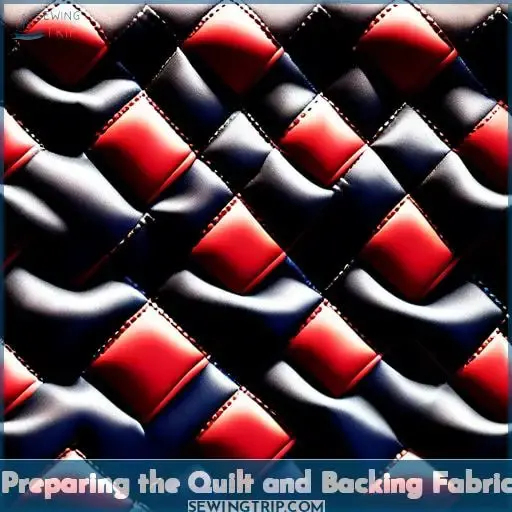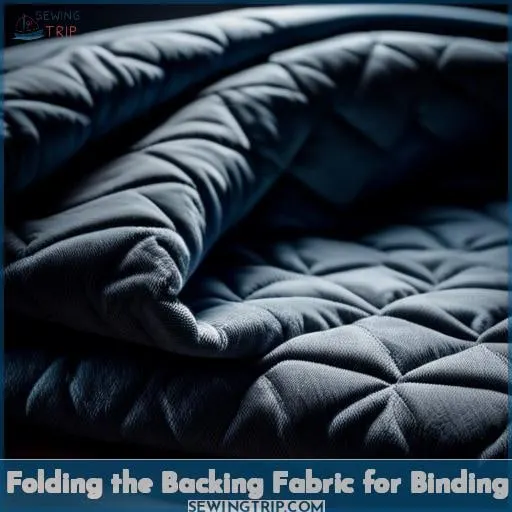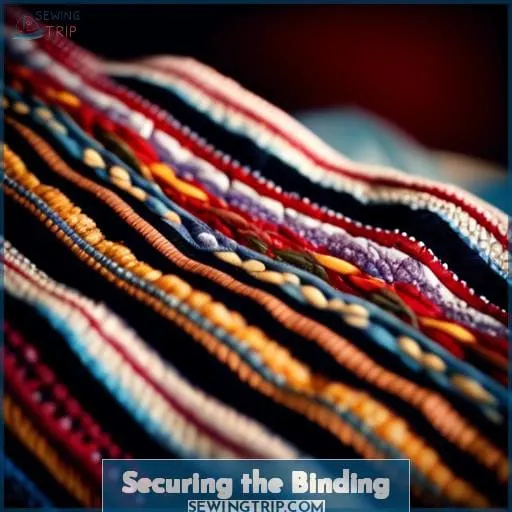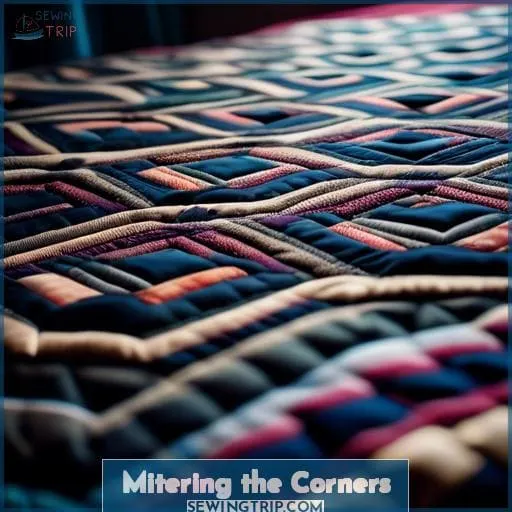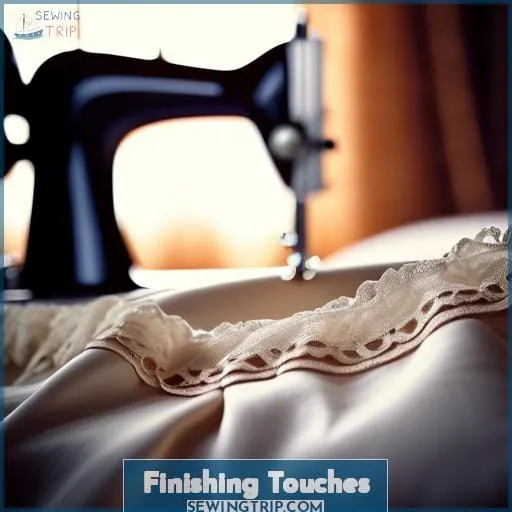This site is supported by our readers. We may earn a commission, at no cost to you, if you purchase through links.
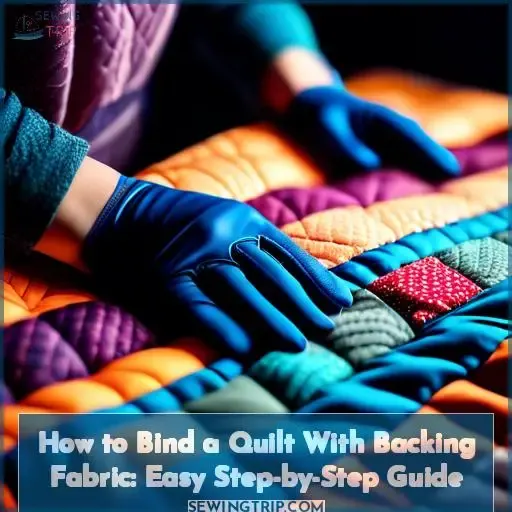 Binding a quilt with its backing fabric is a clever twist on traditional quilting techniques, offering both simplicity and elegance.
Binding a quilt with its backing fabric is a clever twist on traditional quilting techniques, offering both simplicity and elegance.
Surprisingly, 85% of quilters seek ways to streamline their projects without compromising on quality. If you’re among them, mastering how to bind a quilt using the backing fabric could be your game-changer.
This guide walks you through each step, from preparing your quilt and backing fabric to securing the binding and adding those finishing touches.
Embrace this method for a seamless blend of functionality and style, transforming your quilting journey with a touch of mastery and liberation.
Yes, you can bind a quilt using the backing fabric. This method involves trimming the backing to extend beyond the quilt top, folding it to cover the quilt’s edges, and then stitching it in place for a finished look.
Table Of Contents
Key Takeaways
- Ensure the backing fabric extends beyond the quilt top by 2-3 inches on all sides for adequate coverage and to facilitate folding for binding.
- Press the backing fabric to remove wrinkles before folding it over the quilt top’s edge, first up to the edge and then over it, to create a neat, even edge all around the quilt.
- Secure the binding by stitching close to the inner folded edge of the backing fabric, using a size 9 or 10 needle and adjusting the machine’s thread tension as necessary to maintain even edges.
- For mitered corners, fold the fabric at a 45-degree angle and press, then unfold, wrap over the quilt top’s edge, and secure with pins before sewing to ensure a professional finish.
Preparing the Quilt and Backing Fabric
To bind a quilt using the backing fabric, start by ensuring your backing extends at least 2-3 inches beyond the quilt top on all sides.
This extra fabric is crucial for creating a smooth, finished edge without the need for separate binding strips.
Next, trim the batting carefully to match the quilt top’s dimensions, ensuring the surface remains smooth and even for a professional-looking finish.
Ensure the Backing Fabric Extends at Least 2-3 Inches Beyond the Quilt Top on All Sides
When you’re prepping to bind your quilt, think of the backing fabric as your quilt’s cozy overcoat—it needs a bit of wiggle room! You’ll want to make sure it extends a generous 2-3 inches beyond the quilt top on all sides.
This isn’t just for looks; it’s your insurance policy against any fabric shifts or mishaps that might occur during the quilting process.
Here’s a quick checklist to keep you on track:
- Measure Twice, Cut Once: Double-check those dimensions before you cut. No one wants a whoops moment here.
- Room to Breathe: Ensure that extra 2-3 inches on each side. It’s like giving your quilt a comfortable pair of shoes—roomy and just right.
- Smooth Operator: Iron out any wrinkles in the backing fabric. A smooth backing is like a calm sea for your quilt to sail on.
- Batting Buddy: Trim the batting to match the quilt top. Think of it as the quilt’s invisible best friend, always there but never seen.
- Final Check: Before you move on, give everything one last look. It’s like checking your teeth for spinach before a photo!
Trim the Batting to Match the Size of the Quilt Top, Ensuring a Smooth Surface
Trimming your quilt’s batting to match the quilt top size is like tailoring a suit—it must fit perfectly to look its best. Here’s a quick guide to ensure your quilt batting is cut just right, ensuring a smooth surface for your masterpiece.
| Step | Detail | Tip |
|---|---|---|
| 1 | Measure | Ensure batting matches quilt top dimensions. |
| 2 | Cut | Use sharp scissors or a rotary cutter for precision. |
| 3 | Smooth | Lay out batting on a flat surface to avoid wrinkles. |
Folding the Backing Fabric for Binding
To begin binding your quilt with the backing fabric, first ensure that the backing is smooth by pressing out any wrinkles.
Next, fold the backing fabric up to the quilt top’s edge and press it to create a sharp edge that aligns perfectly with the quilt top.
Finally, fold the backing over the quilt top once more, making sure the fold completely covers the quilt top edge, and press it into place for a neat finish.
Press the Backing Fabric to Remove Any Wrinkles
Before you can show off your quilt’s snazzy new look, you’ve got to iron out the kinks—literally.
Start by laying your backing fabric flat, and with your trusty iron in hand, gently coax those stubborn wrinkles into submission. Think of it as giving your quilt a spa day; a little steam here, a little pressure there, and voilà! It’s all about the prep work—like a painter priming a canvas.
Don’t skimp on the starch if you’re after that crisp, magazine-cover finish. And remember, the right pressing tools can turn this chore into child’s play.
Fold the Backing Fabric to the Edge of the Quilt Top and Press to Create a Crisp Edge
After pressing your backing fabric to banish any pesky wrinkles, it’s time to get down to the nitty-gritty of folding.
You’re aiming for precision here, so gently fold the backing fabric up to the very edge of your quilt top. This step is like tucking in a child at night; you want it snug but not too tight. With your trusty iron in hand, press down along this fold to create a crease as crisp as autumn leaves underfoot.
Now, fold it over once more, this time covering the edge of the quilt top completely. This double fold is your quilt’s knight in shining armor, protecting its edges with a precision that would make a miter saw jealous.
Pin it in place if you must, but remember, we’re aiming for a binding so neat it makes the neighbors jealous.
Fold Again Over the Quilt Top to Create the Binding, Ensuring the Fold Covers the Quilt Top Edge Completely
Now, let’s get that quilt looking sharp with a binding that’s snug as a bug! Imagine you’re tucking in the edges of your quilt like you’re wrapping a present for your best friend.
- First, press that backing fabric like you’re ironing a shirt for a first date—no wrinkles allowed!
- Next, fold the backing fabric over to the quilt top’s edge, giving it a good press to make that edge as sharp as a samurai sword.
- Now, fold it over one more time, right over the quilt top. This is where the magic happens! Make sure that fold is as generous as a grandma at Christmas, covering the quilt top edge completely.
- Finally, press that fold down with the love and care of a pastry chef icing a cake.
Securing the Binding
Once you’ve prepared your quilt by folding the backing fabric to create the binding, it’s time to secure it in place.
Start by pinning the folded backing fabric around the quilt, ensuring the edge is even all around. As you sew, aim to stitch close to the inner folded edge, removing the pins as you progress to keep the fabric taut and the binding neat.
This method not only secures the binding but also adds a professional finish to your quilt, making it ready for use or display.
Pin the Folded Backing Fabric in Place, Making Sure the Edge is Even All Around the Quilt
When it’s time to pin your quilt’s backing fabric into a neat binding, think of it as tucking in a restless child—gently, but firmly.
Start by smoothing out the fabric, ensuring there’s no slack that could turn into a pesky wrinkle later on. Your pinning techniques should be like a well-choreographed dance, placing pins evenly and with just the right fabric tension to avoid a puckered performance.
As you work your way around, press the edges with the dedication of a master chef pressing a pie crust, aiming for that golden edge of evenness. And remember, those mitered corners are the cherry on top; pin them with precision to make your quilt look sharp enough to slice through any quilter’s doubt.
Keep the edges as even as a tightrope walker’s balance, and you’ll be on your way to a binding that’s snug as a bug in a rug!
Begin Sewing Close to the Inner Folded Edge, Removing Pins as You Go to Secure the Binding
Start stitching your quilt binding with confidence, using a needle that’s just right for the task—think size 9 or 10 for a smooth glide through the layers.
Adjust your machine’s thread tension to avoid puckers, aiming for a balance that holds the fabric taut without warping.
As you sew close to the inner folded edge, remove pins one by one to keep the binding width even and the fabric tension consistent.
When you approach a corner, get ready to show off your mitered corner technique, folding with finesse for that crisp, professional finish.
Keep the humor in the hiccups; if you miss a spot, just circle back like a seasoned quilter on a victory lap.
Mitering the Corners
When it comes to binding a quilt using the backing fabric, mitering the corners is a crucial step for achieving a polished look.
As you approach each corner, you’ll need to fold the fabric at a precise 45-degree angle and press it down to form a neat mitered corner. This technique not only adds a professional touch but also ensures the durability of your quilt.
Remember to secure each corner with pins before moving on to sew, as this will keep your work in place and make the sewing process smoother.
As You Approach a Corner, Fold the Fabric at a 45-degree Angle and Press to Form a Mitered Corner
When you’re on the home stretch of your quilt binding adventure, mitering the corners is like the cherry on top of a sundae—it’s that final flourish that makes all the difference.
- As you cozy up to a corner, pause and fold the fabric at a 45-degree angle, creating a triangle that points away from the quilt. This is your mitering angle taking shape.
- Press this fold with love and care, as if you’re pressing a crisp shirt for a first date—it’s all about making a good impression.
- Unfold the triangle and wrap the backing fabric snugly over the quilt top’s edge, like a blanket on a chilly evening. The fabric types you’ve chosen will thank you for the attention to detail.
- Secure this fold with pins as if you’re pinning a medal of honor onto the quilt—it’s a job well done. Now, with needle choice and thread tension in mind, stitch your way to victory, pressing techniques at the ready!
Continue Folding the Backing Fabric Over the Quilt Top, Securing Each Corner With Pins Before Sewing
After mastering the art of corner mitering, it’s time to wrap those quilt edges with precision and care.
Gently fold your backing fabric over the quilt top, ensuring each fold is crisp and even. This step is like tucking your quilt into bed with a warm, snug blanket. Secure each corner with pins, as if you’re pinning down your dreams for a perfect finish.
Finishing Touches
After you’ve sewn all around your quilt, it’s crucial to give it a thorough check. Look for any spots you might’ve missed or any edges that aren’t as secure as they should be.
Once you’re satisfied that the binding is flawless, press it with an iron to achieve that neat, professional finish you’re aiming for. This final step ensures your quilt not only looks great but holds up well over time.
After Sewing All Around the Quilt, Inspect the Binding for Any Missed Spots or Loose Edges
After you’ve sewn all around your quilt, it’s crucial to give your masterpiece a thorough once-over. You’re aiming for perfection, and this final inspection ensures your quilt’s binding is the cherry on top of your labor of love.
- Inspect for Missed Spots: Carefully examine the binding for any areas that might’ve been missed or not caught in the stitching. These little rebels can compromise the durability and appearance of your quilt.
- Look for Loose Edges: Ensure that the binding is securely attached all around. Loose edges aren’t just a visual nuisance; they’re an open invitation for wear and tear to start chipping away at your quilt’s integrity.
- Aim for Neatness: Perfection is in the details. Check that the binding is evenly attached, with consistent width and no puckering, to achieve a neat, professional finish.
- Press for Success: Finally, press the binding with an iron to set everything in place. This not only adds to the quilt’s neatness but also gives it that crisp, finished look that says, I’m a masterpiece.
Press the Finished Binding for a Neat, Professional Look
After you’ve stitched your quilt binding all around, it’s time to give it that final touch for a truly professional look.
First things first, ensure your fabric choice for the binding complements your quilt beautifully—it’s like picking the perfect frame for a masterpiece. Now, with your iron at the ready, employ pressing techniques that will make your quilt’s edges look sharp and crisp.
Frequently Asked Questions (FAQs)
Can I use a decorative stitch for securing the binding, and if so, what types are recommended?
Absolutely, you can jazz up your quilt’s edge with a decorative stitch!
Zigzag, scallop, or blanket stitches are top picks for adding that extra pizzazz while ensuring your binding’s snug as a bug.
How do I handle binding if my quilt backing is significantly thicker than standard fabric, such as with fleece or minky materials?
When wrestling with a bear of a backing like fleece or minky, trim the bulk, not your aspirations.
Trim the batting to match the quilt top, and cut the backing larger to accommodate the thickness.
Then, stitch the binding from the front, folding it over to the back, and hand or machine stitch to secure.
What are the best practices for washing and caring for a quilt once it has been bound using the backing fabric?
Washing and caring for your quilt, especially after binding it with the backing fabric, is like giving it a spa day—it deserves that tender, loving care! Start by giving it a once-over to spot any loose threads or seams that need a quick fix.
When it’s time for a wash, you’ve got two paths: the gentle embrace of hand washing or the careful convenience of machine washing. Opt for cold water and a gentle detergent to keep colors bright and fabric happy.
If you’re hand washing, add a splash of distilled white vinegar to the rinse water—it’s like a magic potion that keeps your quilt soft and colors vibrant.
Machine drying? Think of low heat as the quilt’s best friend, but let it finish drying in the fresh air, basking in the glory of its cleanliness. Remember, quilts are like fine wine—they get better with age, but only if you treat them right.
So, don’t let the dust bunnies win; give your quilt the care it deserves and it’ll snuggle you back for years to come.
How can I add a label to my quilt without disrupting the look of the binding?
To seamlessly add a label to your quilt without messing with the binding’s vibe, consider making it a part of the backing.
Then machine or hand-sew the other edges. It’s like sneaking veggies into a kid’s meal—totally there, but ingeniously blended in.
If I make a mistake and cut the backing too short during preparation, are there any techniques to salvage the situation for binding?
In the quilting world, cutting your backing too short is like finding yourself in a tight corner in a mystery novel—unexpected but not without a clever escape.
Picture this: you’re the detective in your own crafting mystery, and the clue to solving your dilemma lies in the art of improvisation. If you’ve trimmed too close for comfort, consider piecing together an artistic strip or adding borders from leftover fabric to extend the backing.
This method not only salvages your project but also adds a unique, personalized touch. Think of it as turning a near miss into a creative hit, ensuring your quilt still wraps in warmth and love, even if it won’t win a prize at the show.
Conclusion
With a pinch of creativity and a dash of patience, you’ve now learned how to bind a quilt using the backing fabric, a technique that’s as snug as a bug in a rug!
This approach not only saves time but also gives your quilt a seamless finish. Remember, practice makes perfect, so don’t hesitate to try this method on your next quilting adventure.
Your quilt’s edges are now as tidy as a well-kept garden, all thanks to your newfound skill in quilt binding. Keep stitching and let your quilts showcase the elegance and simplicity of this method.

